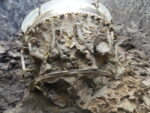 The exceptionally rare diatretic glass vase discovered in a paleochristian necropolis in Autun, central France, last year has been pieced together by conservators, and it’s even rarer than it first appeared to be.
The exceptionally rare diatretic glass vase discovered in a paleochristian necropolis in Autun, central France, last year has been pieced together by conservators, and it’s even rarer than it first appeared to be.
The vase was discovered inside a massive sandstone sarcophagus, one of six found in the necropolis, at the feet of the deceased individual. The necropolis was in use between the early 3rd and the middle of the 5th century, and the glass vase dates to the 4th century.
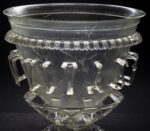 It is made of a reticulated glassware, an elaborate ornamental style featuring interlacing lines of glass in relief. Just 4.7 inches high and 6.3 inches in diameter, the vase is one of only 10 complete examples of Roman reticulated glass known to survive, and the only example ever found in France. It also unique for its inscription: the phrase VIVAS FELICITER (live in happiness) written in large deep relief letters.
It is made of a reticulated glassware, an elaborate ornamental style featuring interlacing lines of glass in relief. Just 4.7 inches high and 6.3 inches in diameter, the vase is one of only 10 complete examples of Roman reticulated glass known to survive, and the only example ever found in France. It also unique for its inscription: the phrase VIVAS FELICITER (live in happiness) written in large deep relief letters.
While it was complete, and large enough pieces survived to make the inscription legible to the naked eye immediately upon discovery, the vase was broken into numerous fragments. The complex restoration was performed by experts at the Römisch-Germanisches Zentralmuseum in Mainz, Germany. Solving the puzzle took five months of work.
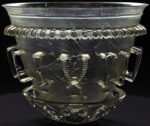 The restoration revealed an egg-and-dart band between the rim and the inscription. The base is decorated with a complex filigree featuring eight heart-shaped ovals that form a circular rosette. It also revealed a separator character, a v-shaped pointed arch crossed at the apex and incised with horizontal ribs, at the end of the inscription.
The restoration revealed an egg-and-dart band between the rim and the inscription. The base is decorated with a complex filigree featuring eight heart-shaped ovals that form a circular rosette. It also revealed a separator character, a v-shaped pointed arch crossed at the apex and incised with horizontal ribs, at the end of the inscription.
The letters are in excellent condition, although it seems the letter C was added in a later repair. The glass in the replacement C has the same chemical composition as the other letters, so it was made at the time the vase was made, but it has a matte finish that is different from the rest of the inscription. Something must have happened during the letter’s production that required it to be remade. The unsuitable C was melted back down and now has a slightly altered look and texture.
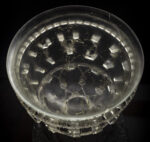 It was composition analysis that exposed the vase’s most surprising secret. Impregnation analyses found a mixture of plant and flower oils were used in the recipe, as was ambergris. Known as whale vomit, ambergris is a waxy substance formed in the intestinal tract of sperm wales that is found very rarely, almost always on beaches, and sells for astronomical sums. Today it is used as a fixative in perfumes, and ancient Egyptians are believed to have burned it like incense, but there are no references to it in classical Greek and Roman sources.
It was composition analysis that exposed the vase’s most surprising secret. Impregnation analyses found a mixture of plant and flower oils were used in the recipe, as was ambergris. Known as whale vomit, ambergris is a waxy substance formed in the intestinal tract of sperm wales that is found very rarely, almost always on beaches, and sells for astronomical sums. Today it is used as a fixative in perfumes, and ancient Egyptians are believed to have burned it like incense, but there are no references to it in classical Greek and Roman sources.
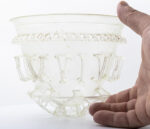 The first European scholar to write about ambergris is believed to have been Byzantine Greek physician Aëtius of Amida. The first important Christian writer on medicine, he mentioned ambergris in his great compilation of Greek medical knowledge written in the late 5th and early 6th centuries. Aëtius included it as an ingredient in spikenard, an expensive perfume referenced repeatedly in the Bible and held to have medicinal properties. As the oil Mary, sister of Lazarus, poured on Jesus’ feet and wiped with her hair (John 12:3), in Christian Europe spikenard was used in the church.
The first European scholar to write about ambergris is believed to have been Byzantine Greek physician Aëtius of Amida. The first important Christian writer on medicine, he mentioned ambergris in his great compilation of Greek medical knowledge written in the late 5th and early 6th centuries. Aëtius included it as an ingredient in spikenard, an expensive perfume referenced repeatedly in the Bible and held to have medicinal properties. As the oil Mary, sister of Lazarus, poured on Jesus’ feet and wiped with her hair (John 12:3), in Christian Europe spikenard was used in the church.
The ambergris found in the diatretic glass vessel is the oldest example of its use on the archaeological record.
“Plant and flower oils” -plus the “amber gris”- were used in the molten glass? 😮
Contrastingly, “Hip(p)ocras(s)” wine was spiced, in France generally prepared with fruits (apples, oranges, almonds) and musk or ambergris. Hippocrates may have known his own recipes, but there are allegedly three different ones fom Plinius, and one from Apicius.
:hattip:
———
“CONDITUM PARADOXUM” (Apicius’ Fine Spiced Wine) – THE COMPOSITION OF EXCELLENT SPICED WINE. INTO A COPPER BOWL PUT 6 SEXTARII [1] OF HONEY AND 2 SEXTARII OF WINE; HEAT ON A SLOW FIRE, CONSTANTLY STIRRING THE MIXTURE WITH A WHIP. AT THE BOILING POINT ADD A DASH OF COLD WINE, RETIRE FROM STOVE AND SKIM. REPEAT THIS TWICE OR THREE TIMES, LET IT REST TILL THE NEXT DAY, AND SKIM AGAIN. THEN ADD 4 OZS. OF CRUSHED PEPPER [2], 3 SCRUPLES OF MASTICH, A DRACHM EACH OF [nard or laurel] LEAVES AND SAFFRON, 5 DRACHMS OF ROASTED DATE STONES CRUSHED AND PREVIOUSLY SOAKED IN WINE TO SOFTEN THEM. WHEN THIS IS PROPERLY DONE ADD 18 SEXTARII OF LIGHT WINE. TO CLARIFY IT PERFECTLY, ADD [crushed] CHARCOAL [3] TWICE OR AS OFTEN AS NECESSARY WHICH WILL DRAW [the residue] TOGETHER [and carefully strain or filter through the charcoal].
———
[1] One sextarius (a “sixth”) equals about 1½ pint English. Apicius is correct in starting with this formula, as all meals were started with this sort of mixed drink.
[2] In connection with honey, sweets, and so forth, the term “pepper” may just as well stand for our all spice, or even for any spicing in general.
[3] Charcoal. Still a favorite filterer for liquors.
That’s the first example of negative-egg-and-dart that I have ever seen.
The “experts at the Römisch-Germanisches Zentralmuseum in Mainz, Germany” must have done jigsaw puzzles as kids!
I’m unclear about whether the ambergris was incorporated into the molten glass, or whether it was found coating the inside of the glass as the remnants of an offering.
Was Aëtius of Amida (Diyarbakır, Turkey) considered European back then? How interesting!